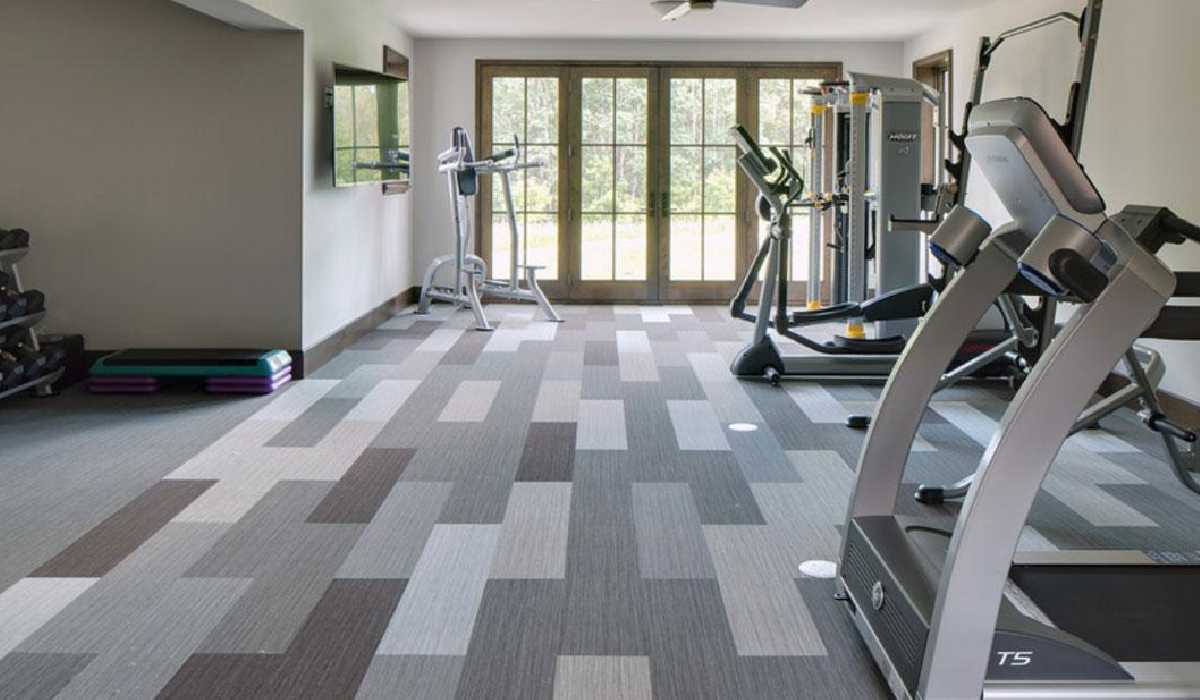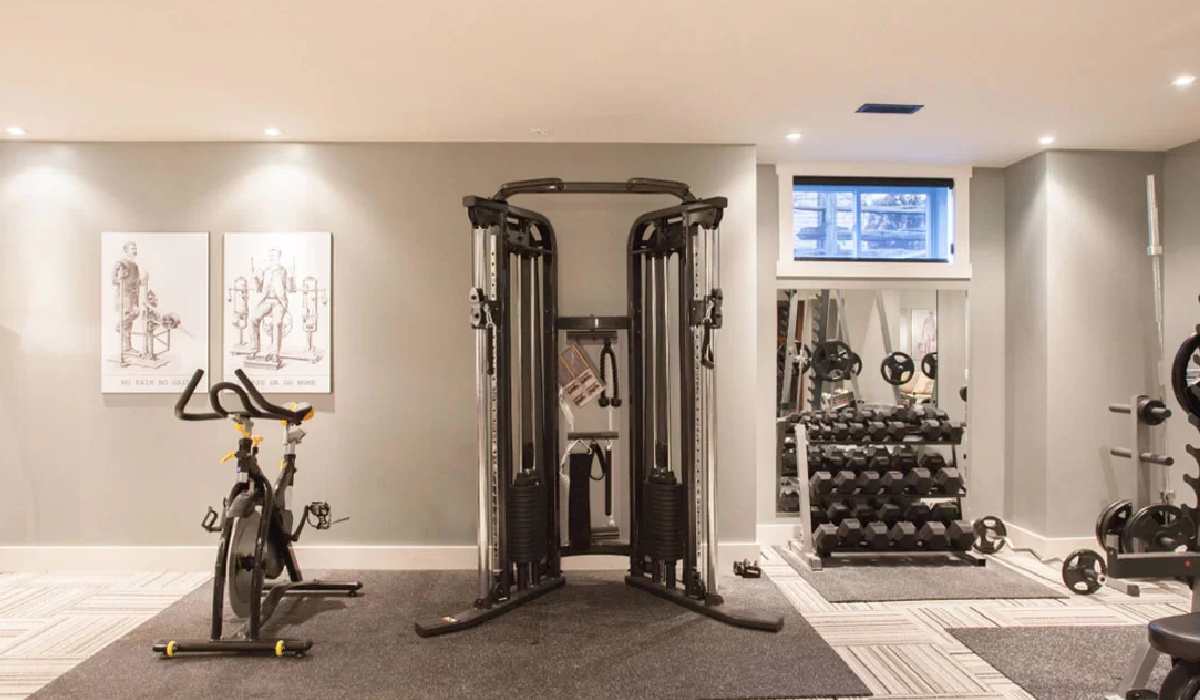The floor tiles used in gymnasiums, sports facilities, fitness centers, and workout room must be firm, safe, yet soft enough to deflect impact. These kinds of applications need flooring that can handle considerable traffic while lowering the danger of damage. Tiles designed specifically for sports floors meet these requirements while also creating a welcoming atmosphere for athletes to compete in. Shock absorption is of particular benefit to athletes who participate in high-performance sports, as these situations provide a greater risk of injury. The capacity of a floor to effectively absorb shocks reduces the amount of physical tiredness and muscle strain that a person experiences. For example, in gymnastics, which involves a lot of powerful and explosive actions, you need cushioning that cushions the impact of hard landings while yet providing a reasonable amount of grip so that you can stay safe.  Floors that are capable of withstanding strong impact without tearing are essential for training facilities that make use of heavy weights and apparatus. The use of high-quality sports flooring in fitness centers and weightlifting areas is quite beneficial since this type of flooring can withstand strenuous exercise without being ripped or torn. For the safety of all visitors, courts, gymnasiums, and areas used for yoga, Pilates, and aerobics must have non-slip surfaces. Courts for basketball, tennis, volleyball, and badminton, both indoor and outdoor, are a few sports applications that call for strong slip resistance. Sports flooring offers a superb ball return, a soft surface that is firm enough for fast movements, and an outstanding grip for unexpected changes of direction. Sports flooring is suitable for a variety of high-impact sports and strong motions and fulfills criteria for stability, traction, and surface wear. Rubber floor tiles offer protection without affecting an athlete's performance. Sports rubber flooring is a great way to absorb and reduce sound in places like gymnasiums and high-traffic areas where sound bounces off the walls and makes a lot of noise. minimize vibration and sound transmission, which will also increase comfort. Fitness centers, courts, and gyms all see a lot of foot traffic every day, emphasizing the need of easy-to-maintain flooring solutions. Rubber sports flooring is water-resistant and relatively simple to maintain. For everyday maintenance, a wet cleanser and a cleanser with a neutral pH are adequate.
Floors that are capable of withstanding strong impact without tearing are essential for training facilities that make use of heavy weights and apparatus. The use of high-quality sports flooring in fitness centers and weightlifting areas is quite beneficial since this type of flooring can withstand strenuous exercise without being ripped or torn. For the safety of all visitors, courts, gymnasiums, and areas used for yoga, Pilates, and aerobics must have non-slip surfaces. Courts for basketball, tennis, volleyball, and badminton, both indoor and outdoor, are a few sports applications that call for strong slip resistance. Sports flooring offers a superb ball return, a soft surface that is firm enough for fast movements, and an outstanding grip for unexpected changes of direction. Sports flooring is suitable for a variety of high-impact sports and strong motions and fulfills criteria for stability, traction, and surface wear. Rubber floor tiles offer protection without affecting an athlete's performance. Sports rubber flooring is a great way to absorb and reduce sound in places like gymnasiums and high-traffic areas where sound bounces off the walls and makes a lot of noise. minimize vibration and sound transmission, which will also increase comfort. Fitness centers, courts, and gyms all see a lot of foot traffic every day, emphasizing the need of easy-to-maintain flooring solutions. Rubber sports flooring is water-resistant and relatively simple to maintain. For everyday maintenance, a wet cleanser and a cleanser with a neutral pH are adequate.  When choosing the flooring for your home gym, it is essential to have a solid understanding of the many flooring options available and which one would work best for your specific routine in order to make the most educated selection possible. Other considerations to make are the dimensions, thickness, and texture of the flooring, in addition to the material and classification of the flooring. Home gyms have a wide variety of flooring options to choose from, including rubber, foam, hardwood, vinyl, and carpeting, to name just a few of the possibilities. A floor that has been cleaned and maintained professionally is beneficial to users who conduct activities such as ironing or yoga. Because the flooring also has an influence on the sound, it is a crucial consideration for everyone who dwells on the second level of a house, whether it be in a high-rise apartment or a fitness center. In addition, the importance of safety cannot be overstated. It is necessary to utilize the right padding to protect your knees and other joints, as well as to prevent injuries caused by weight loss. This protection is very important. Since rubber is the kind of flooring that is most frequently seen in fitness centers, you should give some thought to installing some rubber in your very own home gym.
When choosing the flooring for your home gym, it is essential to have a solid understanding of the many flooring options available and which one would work best for your specific routine in order to make the most educated selection possible. Other considerations to make are the dimensions, thickness, and texture of the flooring, in addition to the material and classification of the flooring. Home gyms have a wide variety of flooring options to choose from, including rubber, foam, hardwood, vinyl, and carpeting, to name just a few of the possibilities. A floor that has been cleaned and maintained professionally is beneficial to users who conduct activities such as ironing or yoga. Because the flooring also has an influence on the sound, it is a crucial consideration for everyone who dwells on the second level of a house, whether it be in a high-rise apartment or a fitness center. In addition, the importance of safety cannot be overstated. It is necessary to utilize the right padding to protect your knees and other joints, as well as to prevent injuries caused by weight loss. This protection is very important. Since rubber is the kind of flooring that is most frequently seen in fitness centers, you should give some thought to installing some rubber in your very own home gym.  Superior for usage in instructional settings. Rubber floors are not as prone to denting, scratching, or scratches as hardwood or foam floors are. Rubber floors are more resistant to these types of damage. You may cut it into squares that interlock to form tiles for larger areas or entire studios, or you can use it as a mat to cover a smaller surface area. Either way, it is versatile. On the other hand, when compared to the other options for a home gym floor, this one has the most expensive price tag. In addition to these advantages, foam flooring may also be purchased in a variety of dimensions and arrangements, and it helps mitigate the effects of stress. In spite of the fact that they do not last as long as floors made of rubber, they are much cheaper. In addition, outdated tiles may be easily replaced with brand new ones and do not provide any significant challenges. When looking for the perfect flooring for your home gym, pay attention to the measurements as well as the thickness of the different alternatives. When performing high-impact exercises, it is preferable to have a surface that is thick since a floor that absorbs less shock may induce joint strain if the floor is not thick enough. When it comes to keeping your gear safe, thickness is another incredibly important issue to take into consideration. If you drop a dumbbell onto a hard concrete floor, the weight could get damaged, and as a result, the floor might chip or crack. Lifting weights, practicing yoga, or participating in a Zumba dance are just a few examples of the various activities that call for an efficient and stable footing in order to be carried out effectively.
Superior for usage in instructional settings. Rubber floors are not as prone to denting, scratching, or scratches as hardwood or foam floors are. Rubber floors are more resistant to these types of damage. You may cut it into squares that interlock to form tiles for larger areas or entire studios, or you can use it as a mat to cover a smaller surface area. Either way, it is versatile. On the other hand, when compared to the other options for a home gym floor, this one has the most expensive price tag. In addition to these advantages, foam flooring may also be purchased in a variety of dimensions and arrangements, and it helps mitigate the effects of stress. In spite of the fact that they do not last as long as floors made of rubber, they are much cheaper. In addition, outdated tiles may be easily replaced with brand new ones and do not provide any significant challenges. When looking for the perfect flooring for your home gym, pay attention to the measurements as well as the thickness of the different alternatives. When performing high-impact exercises, it is preferable to have a surface that is thick since a floor that absorbs less shock may induce joint strain if the floor is not thick enough. When it comes to keeping your gear safe, thickness is another incredibly important issue to take into consideration. If you drop a dumbbell onto a hard concrete floor, the weight could get damaged, and as a result, the floor might chip or crack. Lifting weights, practicing yoga, or participating in a Zumba dance are just a few examples of the various activities that call for an efficient and stable footing in order to be carried out effectively.  The risk of tripping and falling, both of which can result in injury, is increased when the flooring is slippery. Those who are wearing shoes intended for athletics will find that the surface of the rubber and foam floor provides an adequate level of grip. Low-pile rugs often contain a subtle rib pattern to give traction and are created to be simpler to clean than high-pile rugs. Despite the fact that hardwood and vinyl floors offer a smoother surface, these types of gym flooring are an excellent choice for athletes who want to wear shoes with a rubber sole. It contributes to the provision of traction.
The risk of tripping and falling, both of which can result in injury, is increased when the flooring is slippery. Those who are wearing shoes intended for athletics will find that the surface of the rubber and foam floor provides an adequate level of grip. Low-pile rugs often contain a subtle rib pattern to give traction and are created to be simpler to clean than high-pile rugs. Despite the fact that hardwood and vinyl floors offer a smoother surface, these types of gym flooring are an excellent choice for athletes who want to wear shoes with a rubber sole. It contributes to the provision of traction.
💰 Tenfold your income 💎
